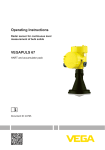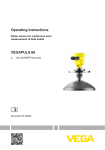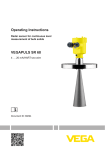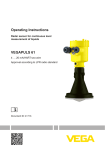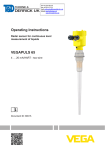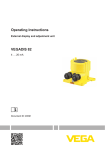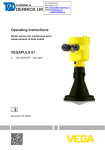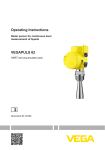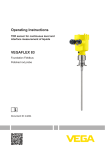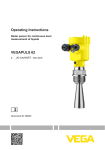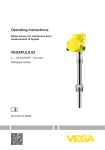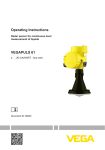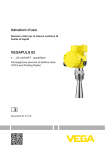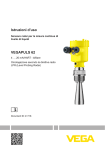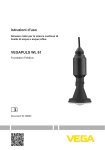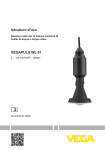Download Operating Instructions VEGAPULS 69
Transcript
Operating Instructions Radar sensor for continuous level measurement of bulk solids VEGAPULS 69 4 … 20 mA/HART - four-wire Document ID: 47249 Contents Contents About this document 1.1 Function ........................................................................................................................... 4 1.2 Target group ..................................................................................................................... 4 1.3 Symbols used................................................................................................................... 4 2 For your safety 2.1 Authorised personnel ....................................................................................................... 5 2.2 Appropriate use ................................................................................................................ 5 2.3 Warning about incorrect use............................................................................................. 5 2.4 General safety instructions ............................................................................................... 5 2.5 CE conformity................................................................................................................... 6 2.6 NAMUR recommendations .............................................................................................. 6 2.7 Radio license for Europe .................................................................................................. 6 2.8 Environmental instructions ............................................................................................... 7 3 Product description 3.1 Configuration .................................................................................................................... 8 3.2 Principle of operation........................................................................................................ 9 3.3 Packaging, transport and storage ................................................................................... 10 3.4 Accessories and replacement parts ............................................................................... 10 4 Mounting 4.1 General instructions ....................................................................................................... 13 4.2 Mounting versions, plastic horn antenna ........................................................................ 13 4.3 Mounting preparations, mounting strap .......................................................................... 16 4.4 Mounting instructions ..................................................................................................... 16 5 Connecting to power supply 5.1 Preparing the connection ............................................................................................... 27 5.2 Connection ..................................................................................................................... 28 5.3 Wiring plan, double chamber housing ............................................................................ 29 5.4 Double chamber housing with DIS-ADAPT .................................................................... 31 5.5 Switch-on phase............................................................................................................. 31 6 Set up with the display and adjustment module 6.1 Insert display and adjustment module ............................................................................ 33 6.2 Adjustment system ......................................................................................................... 34 6.3 Measured value indication - Selection national language ............................................... 34 6.4 Parameter adjustment - Quick setup .............................................................................. 35 6.5 Parameter adjustment - Extended adjustment................................................................ 36 6.6 Saving the parameter adjustment data ........................................................................... 50 7 Setup with PACTware 7.1 Connect the PC .............................................................................................................. 52 7.2 Parameter adjustment .................................................................................................... 53 7.3 Saving the parameter adjustment data ........................................................................... 54 8 Set up with other systems 8.1 DD adjustment programs ............................................................................................... 55 8.2 Field Communicator 375, 475 ........................................................................................ 55 9 Diagnosis, asset management and service 9.1 Maintenance .................................................................................................................. 56 2 VEGAPULS 69 • 4 … 20 mA/HART - four-wire 47249-EN-140707 1 Contents 9.2 9.3 9.4 9.5 9.6 9.7 Measured value and event memory ............................................................................... 56 Asset Management function ........................................................................................... 57 Rectify faults ................................................................................................................... 61 Exchanging the electronics module ................................................................................ 64 Software update ............................................................................................................. 65 How to proceed if a repair is needed .............................................................................. 65 10 Dismount 10.1 Dismounting steps.......................................................................................................... 66 10.2 Disposal ......................................................................................................................... 66 47249-EN-140707 11 Supplement 11.1 Technical data ................................................................................................................ 67 11.2 Radio astronomy stations ............................................................................................... 74 11.3 Dimensions .................................................................................................................... 75 Safety instructions for Ex areas PleasenotetheEx-specificsafetyinformationforinstallationandoperation in Ex areas. These safety instructions are part of the operating instructions manual and come with the Ex-approved instruments. Editing status:2014-07-07 VEGAPULS 69 • 4 … 20 mA/HART - four-wire 3 1 About this document 1 About this document 1.1 Function 1.2 Target group 1.3 Symbols used This operating instructions manual provides all the information you need for mounting, connection and setup as well as important instructionsformaintenanceandfaultrectification.Pleasereadthisinformation before putting the instrument into operation and keep this manual accessible in the immediate vicinity of the device. This operating instructions manual is directed to trained specialist personnel. The contents of this manual should be made available to these personnel and put into practice by them. Information, tip, note This symbol indicates helpful additional information. Caution: If this warning is ignored, faults or malfunctions can result. Warning: If this warning is ignored, injury to persons and/or serious damage to the instrument can result. Danger: If this warning is ignored, serious injury to persons and/or destruction of the instrument can result. • → 1 Ex applications This symbol indicates special instructions for Ex applications. List The dot set in front indicates a list with no implied sequence. Action This arrow indicates a single action. Sequence of actions Numbers set in front indicate successive steps in a procedure. Battery disposal This symbol indicates special information about the disposal of batteries and accumulators. 47249-EN-140707 4 VEGAPULS 69 • 4 … 20 mA/HART - four-wire 2 For your safety 2 2.1 For your safety Authorised personnel All operations described in this operating instructions manual must be carried out only by trained specialist personnel authorised by the plant operator. During work on and with the device the required personal protective equipment must always be worn. 2.2 Appropriate use VEGAPULS 69 is a sensor for continuous level measurement. Youcanfinddetailedinformationabouttheareaofapplicationin chapter "Product description". Operational reliability is ensured only if the instrument is properly usedaccordingtothespecificationsintheoperatinginstructions manual as well as possible supplementary instructions. 2.3 Warning about incorrect use 2.4 General safety instructions Inappropriate or incorrect use of the instrument can give rise to application-specifichazards,e.g.vesseloverfillordamagetosystem components through incorrect mounting or adjustment. This is a state-of-the-art instrument complying with all prevailing regulations and guidelines. The instrument must only be operated in a technicallyflawlessandreliablecondition.Theoperatorisresponsible for the trouble-free operation of the instrument. During the entire duration of use, the user is obliged to determine the compliance of the necessary occupational safety measures with the current valid rules and regulations and also take note of new regulations. The safety instructions in this operating instructions manual, the national installation standards as well as the valid safety regulations and accident prevention rules must be observed by the user. For safety and warranty reasons, any invasive work on the device beyond that described in the operating instructions manual may be carried out only by personnel authorised by the manufacturer. Arbitraryconversionsormodificationsareexplicitlyforbidden. 47249-EN-140707 The safety approval markings and safety tips on the device must also be observed. Depending on the instrument version, the emitting frequencies are in the C or K band range. The low emitting frequencies are far below the internationally approved limit values. When used correctly, there is no danger to health. VEGAPULS 69 • 4 … 20 mA/HART - four-wire 5 2 For your safety 2.5 CE conformity ThedevicefulfillsthelegalrequirementsoftheapplicableECguidelines.ByaffixingtheCEmarking,weconfirmsuccessfultestingofthe product. YoucanfindtheCECertificateofConformityinthedownloadsection of our homepage. Electromagnetic compatibility Instruments in four-wire or Ex-d-ia version are designed for use in an industrial environment. Nevertheless, electromagnetic interference from electrical conductors and radiated emissions must be taken into account, as is usual with class A instruments according to EN 613261.Iftheinstrumentisusedinadifferentenvironment,theelectromagnetic compatibility to other instruments must be ensured by suitable measures. 2.6 NAMUR recommendations NAMUR is the automation technology user association in the process industry in Germany. The published NAMUR recommendations are acceptedasthestandardinfieldinstrumentation. ThedevicefulfillstherequirementsofthefollowingNAMURrecommendations: • • • • NE 21 – Electromagnetic compatibility of equipment NE 43 – Signal level for malfunction information from measuring transducers NE53–Compatibilityoffielddevicesanddisplay/adjustment components NE107–Self-monitoringanddiagnosisoffielddevices For further information see www.namur.de. 2.7 Radio license for Europe The instrument meets the LPR (Level Probing Radar) radio standard EN 302729-1/2. It is approved for unrestricted use inside and outside of closed vessels in countries of the EU and EFTA that have implemented this standard. For operation outside of closed vessels, the following conditions must befulfilled: • • • 6 VEGAPULS 69 • 4 … 20 mA/HART - four-wire 47249-EN-140707 • Theinstallationmustbecarriedoutbytrainedqualifiedpersonnel The instrument must be stationary mounted and the antenna directed vertically downward The mounting location must be at least 4 km away from the radio astronomy stations, unless special permission was granted by the responsible national approval authority When installed within 4 to 40 km of a radio astronomy station, the instrument must not be mounted higher than 15 m above the ground. 2 For your safety Youcanfindalistwiththerespectiveradioastronomystationsin chapter "Supplement". 2.8 Environmental instructions Protection of the environment is one of our most important duties. That is why we have introduced an environment management system with the goal of continuously improving company environmental protection.Theenvironmentmanagementsystemiscertifiedaccording to DIN EN ISO 14001. Pleasehelpusfulfillthisobligationbyobservingtheenvironmental instructions in this manual: Chapter "Packaging, transport and storage" Chapter "Disposal" 47249-EN-140707 • • VEGAPULS 69 • 4 … 20 mA/HART - four-wire 7 3 Product description 3 Type label Product description 3.1 Configuration Thetypelabelcontainsthemostimportantdataforidentificationand use of the instrument: 1 2 3 15 4 5 6 7 8 9 13 10 11 14 12 Fig. 1: Layout of the type label (example) 1 Instrument type 2 Product code 3 Approvals 4 Power supply and signal output, electronics 5 Protection rating 6 Measuring range 7 Process and ambient temperature, process pressure 8 Material, wetted parts 9 Hardware and software version 10 Order number 11 Serial number of the instrument 12 Data-Matrix-Code for Smartphone-App 13 Symbol of the device protection class 14 ID numbers, instrument documentation 15 Reminder to observe the instrument documentation 16 NotifiedauthorityforCEmarking 17 Approval directive Serial number - Instrument search The type label contains the serial number of the instrument. With it youcanfindthefollowinginstrumentdataonourhomepage: • • • • Go to www.vega.com, "VEGATools" and "Instrument search". Enter the serial number. Alternatively, you can access the data via your smartphone: 8 VEGAPULS 69 • 4 … 20 mA/HART - four-wire 47249-EN-140707 • • Product code (HTML) Delivery date (HTML) Order-specificinstrumentfeatures(HTML) Operating instructions and quick setup guide at the time of shipment (PDF) Order-specificsensordataforanelectronicsexchange(XML) Testcertificate(PDF)-optional 3 Product description • • • Download the smartphone app "VEGATools" from the "Apple App Store" or the "GooglePlayStore" Scan the Data Matrix code on the type label of the instrument or Enter the serial number manually in the app Scope of this operating instructions manual This operating instructions manual applies to the following instrument versions: Scope of delivery The scope of delivery encompasses: • • • • • Hardware version from 1.0.0 Software version from 1.0.1 Radar sensor Documentation – Quick setup guide VEGAPULS 69 – Instructions for optional instrument features – Ex-specific"Safety instructions" (with Ex versions) – ifnecessary,furthercertificates DVD "Software & Documents", containing – Operating instructions – Safety instructions – PACTware/DTM-Collection – Driver software Information: In this operating instructions manual, the optional instrument features are described. The respective scope of delivery results from the order specification. Application area 3.2 Principle of operation The VEGAPULS 69 is a radar sensor for continuous level measurementofbulksolidsevenunderthemostdifficultprocessconditions and in wide measuring ranges. Itisidealforuseinhigh,slendersilos,withpoorelyreflectionbulk solidssuchasflyash,plasticgranulesorwoodchipsaswellasstrong falsereflectionsbyinstallations.Thisismadepossiblethankstothe functional principle, a distance measurement through frequency shifting with a particularly small antenna opening angle. Theinstrumentisavailablewithdifferentantennasystemsandequipment for virtually all applications and processes: 47249-EN-140707 • • • Functional principle Plastic horn antenna or metal jacketed lens antenna Optional or integrated rinsing air connection Swivelling holder with seal against the process The instrument emits a continuous radar signal via its antenna. This signal is frequency modulated with a sawtooth form. The emitted signalisreflectedbythemediumandreceivedbytheantennaasecho. The frequency of the received signal always deviates from the actual emittingfrequency.Thefrequencydifferenceisproportionaltothe distanceandthustothefillingheight.Thisdifferenceiscalculated VEGAPULS 69 • 4 … 20 mA/HART - four-wire 9 3 Product description viaspecialalgorithmsinthesensorelectronics.Thedeterminedfilling height is then converted into a corresponding output signal and outputted as the measured value. Packaging 3.3 Packaging, transport and storage Your instrument was protected by packaging during transport. Its capacity to handle normal loads during transport is assured by a test based on ISO 4180. The packaging of standard instruments consists of environmentfriendly, recyclable cardboard. For special versions, PE foam or PE foil is also used. Dispose of the packaging material via specialised recycling companies. Transport Transport must be carried out in due consideration of the notes on the transport packaging. Nonobservance of these instructions can cause damage to the device. Transport inspection The delivery must be checked for completeness and possible transit damage immediately at receipt. Ascertained transit damage or concealed defects must be appropriately dealt with. Storage Up to the time of installation, the packages must be left closed and stored according to the orientation and storage markings on the outside. Unless otherwise indicated, the packages must be stored only under the following conditions: Storage and transport temperature PLICSCOM • • • • • • • Not in the open Dry and dust free Not exposed to corrosive media Protected against solar radiation Avoiding mechanical shock and vibration Storage and transport temperature see chapter "Supplement Technicaldata-Ambientconditions" Relative humidity 20 … 85 % 3.4 Accessories and replacement parts The display and adjustment module PLICSCOM is used for measured value indication, adjustment and diagnosis. It can be inserted into the sensor or the external display and adjustment unit and removed at any time. Youcanfindfurtherinformationintheoperatinginstructions"Display and adjustment module PLICSCOM" (Document-ID 27835). The interface adapter VEGACONNECT enables the connection of communication-capable instruments to the USB interface of a PC. For parameter adjustment of these instruments, the adjustment software PACTware with VEGA-DTM is required. Youcanfindfurtherinformationintheoperatinginstructions"Interface adapterVEGACONNECT" (Document-ID 32628). 10 VEGAPULS 69 • 4 … 20 mA/HART - four-wire 47249-EN-140707 VEGACONNECT 3 Product description VEGADIS 81 The VEGADIS 81 is an external display and adjustment unit for VEGA plics® sensors. For sensors with double chamber housing the interface adapter "DISADAPT" is also required for VEGADIS 81. Youcanfindfurtherinformationintheoperatinginstructions"VEGADIS81" (Document-ID 43814). DIS-ADAPT The adapter "DIS-ADAPT" is an accessory part for sensors with double chamber housings. It enables the connection of VEGADIS 81 to the sensor housing via an M12 x 1 plug. Youcanfindfurtherinformationinthesupplementaryinstructions "AdapterDISADAPT" (Document-ID 45250). VEGADIS 82 VEGADIS 82 is suitable for measured value indication and adjustment of sensors with HART protocol. It is looped into the 4 … 20 mA/HART signal cable. Youcanfindfurtherinformationintheoperatinginstructions"VEGADIS82" (Document-ID 45300). PLICSMOBILE T61 PLICSMOBILE T61 is an external GSM/GPRS radio unit for transmission of measured values and for remote parameter adjustment of plics® sensors. Adjustment is carried out via PACTware/DTM and the integrated USB connection. Youcanfindfurtherinformationinthesupplementaryinstructions "PLICSMOBILET61" (Document-ID 37700). Protective cap The protective cover protects the sensor housing against soiling and intense heat from solar radiation. Youwillfindadditionalinformationinthesupplementaryinstructions manual "Protective cover" (Document-ID 34296). Flanges Screwedflangesareavailableindifferentversionsaccordingtothe following standards: DIN 2501, EN 1092-1, BS 10, ANSI B 16.5, JIS B 2210-1984, GOST 12821-80. Youcanfindadditionalinformationinthesupplementaryinstructions manual "FlangesaccordingtoDIN-EN-ASME-JIS" (Document-ID 31088). Flanges with plastic horn antenna For mounting the instrument with plastic horn antenna to a socket, twoflangeversionsareavailable:thecombicompressionflangeand theadapterflange 47249-EN-140707 Youcanfindadditionalinformationinchapter"Mounting" of this operating instruction. Mounting strap with plas- A mounting strap is available for mounting the instrument with plastic tic horn antenna horn antenna to the wall or ceiling. Youcanfindadditionalinformationinchapter"Mounting" of this operating instruction. VEGAPULS 69 • 4 … 20 mA/HART - four-wire 11 3 Product description Electronics module Electronics module "VEGAPULS series 60" is a replacement part for radarsensorsofVEGAPULSseries60.Adifferentversionisavailable for each type of signal output. Youcanfindfurtherinformationintheoperatinginstructions"ElectronicsmoduleVEGAPULSseries60" (Document-ID 36801). Supplementary electronics 4 … 20 mA/HART four-wire The supplementary electronics is a replacement part for the following sensors with 4 … 20 mA/HART - two-wire: • • • VEGAPULS series 60 VEGAFLEX80series VEGABAR series 80 Youcanfindfurtherinformationintheoperatinginstructions"Supplementaryelectronicsfor4…20mA/HART-four-wire" (Document-ID 42766). 47249-EN-140707 12 VEGAPULS 69 • 4 … 20 mA/HART - four-wire 4 Mounting 4 Protection against moisture Mounting 4.1 General instructions Protect your instrument against moisture ingress through the following measures: • • • Use the recommended cable (see chapter "Connecting to power supply") Tighten the cable gland Loop the connection cable downward in front of the cable gland This applies particularly to: • • • Outdoor mounting Installations in areas where high humidity is expected (e.g. through cleaning processes) Installations on cooled or heated vessels Suitability for the process Make sure that all parts of the instrument exposed to the process are conditions suitable for the existing process conditions. These are mainly: • • • Active measuring component Processfitting Process seal • • • • Process pressure Process temperature Chemical properties of the medium Abrasionandmechanicalinfluences Process conditions are particularly: Youcanfinddetailedinformationontheprocessconditionsinchapter "Technicaldata" as well as on the type label. Mounting strap 4.2 Mounting versions, plastic horn antenna The optional mounting strap allows simple mounting of the instrument on a wall, ceiling or boom. Especially with open vessels, this is a simpleandeffectivewaytoalignthesensortothesurfaceofthebulk solid material. The following versions are available: • • 47249-EN-140707 Mounting strap - Ceiling mounting Length 300 mm Length 170 mm The instrument is normally mounted with a strap vertically on the ceiling. This allows swivelling the sensor up to 180° for optimal orientation and rotating for optimal connection. VEGAPULS 69 • 4 … 20 mA/HART - four-wire 13 4 Mounting Fig. 2: Ceiling mounting via the mounting strap with length 300 mm Fig. 3: Rotating with ceil mounting Mounting strap - Wall mounting Asanalternativethestrapmountingiscarriedouthorizontallyor obliquely. > 200 mm (7.87") Fig. 4: Wall mounting horizontally via the mounting strap with length 170 mm 47249-EN-140707 14 VEGAPULS 69 • 4 … 20 mA/HART - four-wire 4 Mounting Fig. 5: Wall mounting with inclined wall via the mounting strap with length 300 mm Flange Two versions are available for mounting the instrument on a socket: • • CombicompressionflangefittingtoDN80(ASME3"andJIS80) AdapterflangefromDN100(ASME4"orJIS100) In the case of instruments with single chamber housing, the compressionflangecanbepasseddirectlyoverthehousing.Withdouble chamber housings, a later mounting this way is not possible, the mountingmethodmustbespecifiedwhenordering. 1 Fig.6:Combicompressionflange 47249-EN-140707 1 Combicompressionflange VEGAPULS 69 • 4 … 20 mA/HART - four-wire 15 4 Mounting 1 2 3 Fig.7:Adapterflange 1 Connection screw 2 Adapterflange 3 Process seal Youcanfinddrawingsofthesemountingoptionsinchapter"Dimensions". 4.3 Mounting preparations, mounting strap The strap is supplied unassembled and must be screwed to the sensor before setup with three hexagon screws M5 x 10 and spring washers. Max. torque, see chapter "Technicaldata". Required tools: Allenwrenchsize4. There are two ways to screw the strap onto the sensor. Depending on the selected version, the sensors can be swivelled in the strap as follows: • • Polarisation Single chamber housing – Angleofinclination180°,infinitelyvariable – Angle of inclination in three steps 0°, 90° and 180° Double chamber housing – Angleofinclination90°,infinitelyvariable – Angle of inclination in two steps 0° and 90° 4.4 Mounting instructions Radar sensors for level measurement emit electromagnetic waves. Thepolarizationisthedirectionoftheelectricalcomponentofthese waves. Thepolarizationdirectionismarkedbyanoseonthehousing,see following drawing: 47249-EN-140707 16 VEGAPULS 69 • 4 … 20 mA/HART - four-wire 4 Mounting 1 Fig. 8: Position of the polarisation 1 Nose for marking the direction of polarisation Information: Whenthehousingisrotated,thedirectionofpolarizationchanges andhencetheinfluenceofthefalseechoonthemeasuredvalue. Please keep this in mind when mounting or making changes later. Installation position Mount the sensor at least 200 mm (7.874 in) away from the vessel wall. 200 mm (7.87") Fig. 9: Mounting the radar sensor on the vessel top If you cannot maintain this distance, you should carry out a false signal storage during setup. This applies particularly if buildup on the vessel wall is expected. In such cases, we recommend repeating the false signal storage at a later date with existing buildup. Inflowingmedium Theinstrumentshouldnotbemountedtooclosetotheinflowing medium, as the microwave signal could be disrupted. 47249-EN-140707 Silowithfillingfromtop Theoptimalmountingpositionisoppositethefillingaperture.Toavoid heavysoiling,thedistancetoanyfilterordustexhaustershouldbeas large as possible. VEGAPULS 69 • 4 … 20 mA/HART - four-wire 17 4 Mounting Fig.10:Mountingoftheradarsensorwithinflowingmedium Silowithlateralfilling Inbulksolidssiloswithlateralpneumaticfillingtheinstrumentshould notbemountedabovethefillingstream,asthemicrowavesignalwill bedisrupted.Theoptimalmountingpositionisnexttothefillingaperture.Toavoidheavysoiling,thedistancetoanyfilterordustexhauster should be as large as possible. 47249-EN-140707 18 VEGAPULS 69 • 4 … 20 mA/HART - four-wire 4 Mounting Fig.11:Mountingoftheradarsensorwithinflowingmedium Type of socket Information: The mounting socket should be as short as possible and its end rounded. This reduces false echoes from the vessel mounting socket. 47249-EN-140707 Fig. 12: Recommended socket mounting fthemediumhasgoodreflectiveproperties,youcanalsomountthe VEGAPULS 69 on longer sockets. Approximate socket heights are shown in the following illustration. Information: When mounting on longer sockets, we recommend carrying out a false echo storage (see chapter "Parameter adjustment"). VEGAPULS 69 • 4 … 20 mA/HART - four-wire 19 h 4 Mounting d The below charts specify the max. socket piece h depending on the diameter d. Orientation Socket diameter d Socket length h 80 mm ≤200mm 100 mm ≤300mm 150 mm ≤500mm Socket diameter d Socket length h 3" ≤7.87in 4" ≤11.8in 6" ≤19.7in In order to measure as much of the vessel volume as possible, the sensor should be aligned so that the measuring beam reaches the lowest level in the vessel. In a cylindrical silo with conical outlet, the sensor is mounted anywhere from one third to one half of the vessel radius from outside wall (see following drawing). 47249-EN-140707 20 VEGAPULS 69 • 4 … 20 mA/HART - four-wire 4 Mounting r 1/3 r...1/2 r Fig. 14: Mounting position and orientation 47249-EN-140707 With the help of an optional swivelling holder, the sensor can be easily aligned to the vessel centre. The necessary angle of inclination depends on the vessel dimensions. It can be easily checked with a suitable bubble tube or mechanic's level on the sensor. VEGAPULS 69 • 4 … 20 mA/HART - four-wire 21 4 Mounting d α a Fig.15:ProposalforinstallationafterorientationVEGAPULS69 The following table shows the necessary angle of inclination. It depends on the measuring distance and the distance "a" between vessel centre and installation position. Distance d 2° (m) 6° 8° 10° 2 0.1 0.1 0.2 0.3 0.4 4 0.1 0.3 0.4 0.6 0.7 6 0.2 0.4 0.6 0.8 1.1 8 0.3 0.6 0.8 1.1 1.4 10 0.3 0.7 1.1 1.4 1.8 15 0.5 1.0 1.6 2.1 2.6 20 0.7 1.4 2.1 2.8 3.5 25 0.9 1.7 2.6 3.5 4.4 30 1 2.1 3.2 4.2 5.3 35 1.2 2.4 3.7 4.9 6.2 40 1.4 2.8 4.2 5.6 7.1 45 1.6 3.1 4.7 6.3 7.9 50 1.7 3.5 5.3 7 8.8 60 2.1 4.2 6.3 8.4 10.5 70 2.4 4.9 7.3 9.7 12.2 VEGAPULS 69 • 4 … 20 mA/HART - four-wire 47249-EN-140707 22 4° 4 Mounting Distance d 2° (m) 4° 6° 8° 10° 80 2.8 5.6 8.4 11.1 13.9 90 3.1 6.3 9.4 12.5 15.6 100 3.5 7 10.5 13.9 17.4 110 3.8 7.7 11.5 15.3 19.1 120 4.2 8.4 12.5 16.7 20.8 Example: In a vessel 20 m high, the installation position of the sensor is 1.4 m from the vessel centre. The necessary angle of inclination of 4° can be read out from this chart. Proceed as follows to adjust the angle of inclination with the swivelling holder: 1. Loosen the six clamping screws on the swivelling holder with a size5Allenwrench. 2. Align the sensor, check angle of inclination Information: The max. angle of inclination of the swivelling holder is approx. 10° 3. Tighten the clamping screws, torque max. 8 Nm. Vessel installations The mounting location of the radar sensor should be a place where no otherequipmentorfixturescrossthepathofthemicrowavesignals. Vessel installations, such as e.g. ladders, limit switches, heating spirals, struts, etc., can cause false echoes and impair the useful echo. Make sure when planning your measuring site that the radar sensor has a "clear view" to the measured product. In case of existing vessel installations, a false echo storage should be carried out during setup. 47249-EN-140707 If large vessel installations such as struts or supports cause false echoes, these can be attenuated through supplementary measures. Small,inclinedsheetmetalbafflesabovetheinstallationsscatterthe radarsignalsandpreventdirectinterferingreflections. Fig.16:Coverflat,large-areaprofileswithdeflectors Material heaps Large material heaps are best measured with several instruments, which can be mounted on e.g. traverse cranes. For this type of application it is advantageous to orient the sensor perpendicular to the bulk solid surface. VEGAPULS 69 • 4 … 20 mA/HART - four-wire 23 4 Mounting Thesensorsdonotinfluenceeachother. Information: Keep in mind that for these applications, the sensors are designed for relatively slow level changes. If the sensor is used on a movable boom, the max. measuring rate must be observed (see chapter "Technicaldata"). Fig. 17: Radar sensors on traverse crane Mounting in the vessel insulation Instruments for a temperature range up to 200° C have a spacer betweenprocessfittingandelectronicshousing.Thisspacerisused to thermally decouple the electronics from the high process temperatures. Information: The spacer may only be incorporated up to a maximum of 50 mm into the vessel insulation. Only then is a reliable temperature decoupling guaranteed. 2 3 max. 50 mm (1.97") 1 1 Electronicshousing 2 Spacer 3 Vessel insulation 24 VEGAPULS 69 • 4 … 20 mA/HART - four-wire 47249-EN-140707 Fig. 18: Mounting the instrument on insulated vessels. 4 Mounting Mounting in multiple chamber silo Thewallsofmultiple-chambersilosareoftenmadeofprofilematerial, e.g.profilesheeting,toensuretherequiredstability.Iftheradarsensor is mounted very close to a heavily structured vessel wall, substantialinterferingreflectionscanbegenerated.Thusthesensorshould be mounted at the largest possible distance from the separating wall. The best mounting location is on the outer wall of the silo, with the sensor pointing towards the discharge opening in the silo centre. This can be accomplished, for example, with the mounting strap. 47249-EN-140707 Fig. 19: Installation and orientation in multiple chamber silos Fig. 20: Installation and orientation in multiple chamber silos Dust deposits To avoid heavy buildup and dust on the antenna, the sensor should not be mounted close to the dust exhauster inside the vessel. VEGAPULS 69 • 4 … 20 mA/HART - four-wire 25 4 Mounting To avoid buildup, especially with strong condensation, air rinsing is recommended. Metal jacketed lens antenna The VEGAPULS 69 with metal jacketed lens antenna is equipped with a rinsing air connection as a standard feature. Plastic horn antenna The VEGAPULS 69 with plastic horn antenna is optionally available withrinsingairconnection.Themechanicalconfigurationdiffersaccordingtotheflangeversion. Fig.21:Rinsingairconnectionwithcompressionflange Fig.22:Rinsingairconnectionwithadapterflange 47249-EN-140707 26 VEGAPULS 69 • 4 … 20 mA/HART - four-wire 5 Connecting to power supply 5 Safety instructions Connecting to power supply 5.1 Preparing the connection Always keep in mind the following safety instructions: Warning: Connect only in the complete absence of line voltage. • • • Voltage supply via mains voltage The electrical connection must only be carried out by trained personnel authorised by the plant operator. Generally connect the instrument that connecting and disconnecting is possible in idle state. If overvoltage surges are expected, overvoltage arresters should be installed. In this case, the instrument is designed in protection class I. To maintain this protection class, it is absolutely necessary that the ground conductor be connected to the internal ground terminal. Take note of the national installation regulations. Supply voltage and current signal are carried on separate connection cables if reliable separation is required. The supply voltage range can differdependingontheinstrumentversion. Thedataforpowersupplyarespecifiedinchapter"Technicaldata". Voltage supply via low voltage In this case, the instrument is designed in protection class II. Generallyconnecttheinstrumenttovesselground(potentialequalization) or with plastic vessels to the next ground potential. For this purpose, a ground terminal is located laterally on the instrument housing. Connection cable An approved, three-wire installation cable with PE conductor is required for voltage supply with mains voltage. The 4 … 20 mA current output is connected with standard two-wire cable without screen. If electromagnetic interference is expected which is above the test values of EN 61326-1 for industrial areas, screened cable should be used. Use cable with round cross section for instruments with housing and cablegland.Toensurethesealeffectofthecablegland(IPprotection rating),findoutwhichcableouterdiameterthecableglandissuitable for. Useacableglandfittingthecablediameter. Cable gland ½ NPT With plastic housing, the NPT cable gland or the Conduit steel tube must be screwed without grease into the threaded insert. 47249-EN-140707 Max. torque for all housings see chapter "Technicaldata". Cable screening and grounding If screened cable is required, we recommend connecting the cable screen on both ends to ground potential. In the sensor, the screen must be connected directly to the internal ground terminal. The ground terminal on the outside of the housing must be connected to the ground potential (low impedance). VEGAPULS 69 • 4 … 20 mA/HART - four-wire 27 5 Connecting to power supply In Ex systems, the grounding is carried out according to the installation regulations. Connection technology 5.2 Connection The voltage supply and signal output are connected via the springloaded terminals in the housing. Connection to the display and adjustment module or to the interface adapter is carried out via contact pins in the housing. Information: The terminal block is pluggable and can be removed from the electronics. To do this, lift the terminal block with a small screwdriver and pull it out. When reinserting the terminal block, you should hear it snap in. Connection procedure Proceed as follows: 1. Unscrew the housing cover 2. Loosen compression nuts of the cable glands 3. Remove approx. 10 cm (4 in) of the cable mantle (signal output), strip approx. 1 cm (0.4 in) insulation from the ends of the individual wires 4. Insert the cable into the sensor through the cable entry Fig. 23: Connection steps 5 and 6 5. Insert the wire ends into the terminals according to the wiring plan 28 VEGAPULS 69 • 4 … 20 mA/HART - four-wire 47249-EN-140707 Information: Solidcoresaswellasflexiblecoreswithwireendsleevesareinserteddirectlyintotheterminalopenings.Incaseofflexiblecoreswithout end sleeves, press the terminal from above with a small screwdriver, the terminal opening is then free. When the screwdriver is released, the terminal closes again. 5 Connecting to power supply 6. Check the hold of the wires in the terminals by lightly pulling on them 7. Connect the screen to the internal ground terminal, connect the outer ground terminal to potential equalisation in case of power supply via low voltage 8. Connect the lead cable for power supply in the same way according to the wiring plan, in addition connect the ground conductor to the inner ground terminal when powered with mains voltage. 9. Tighten the compression nut of the cable glands. The seal ring must completely encircle the cables 10. Screw the housing cover back on Theelectricalconnectionisfinished. Information: The terminal blocks are pluggable and can be removed from the housing insert. To do this, lift the terminal block with a small screwdriver and pull it out. When inserting the terminal block again, you should hear it snap in. 5.3 Wiring plan, double chamber housing The following illustrations apply to the non-Ex as well as to the Ex-d version. Electronics compartment 2 4...20mA (+)1 2(-) 1 5 6 7 8 1 Fig.24:Electronicscompartment,doublechamberhousing 1 2 3 Internal connection to the terminal compartment For display and adjustment module or interface adapter Internal connection to the plug connector for external display and adjustment unit (optional) 47249-EN-140707 Information: The connection of an external display and adjustment unit is not possible with this double chamber housing. VEGAPULS 69 • 4 … 20 mA/HART - four-wire 29 5 Connecting to power supply Connection compartment with mains voltage 2(-) 5 common (+)1 IS GND active power supply passive 4...20mA 6 7 8 /L /N PE Fig. 25: Connection compartment with double chamber housing with mains voltage Terminal Function Polarity 1 Voltage supply +/L 2 Voltage supply -/N 5 4 … 20 mA output (active) + 6 4 … 20 mA output (passive) + 7 Mass - output - 8 Function ground with installation according to CSA Connection compartment with low voltage IS GND 2(-) common (+)1 6 7 8 active power supply passive 4...20mA 5 /L /N Fig. 26: Connection compartment with double chamber housing with low voltage Function Polarity 1 Voltage supply +/L 2 Voltage supply -/N 5 4 … 20 mA output (active) + 6 4 … 20 mA output (passive) + 7 Mass - output - 8 Function ground with installation according to CSA VEGAPULS 69 • 4 … 20 mA/HART - four-wire 47249-EN-140707 30 Terminal 5 Connecting to power supply Electronics compartment 5.4 Double chamber housing with DIS-ADAPT 1 2 3 Fig.27:ViewtotheelectronicscompartmentwithDISADAPTforconnectionof the external display and adjustment unit 1 DIS-ADAPT 2 Internal plug connection 3 Plug connector M12 x 1 Assignment of the plug connector 4 3 1 2 Fig. 28: View to the plug connector M12 x 1 1 2 3 4 Pin 1 Pin 2 Pin 3 Pin 4 Contact pin Colour connection cable in the sensor Terminal, electronics module Pin 1 Brown 5 Pin 2 White 6 Pin 3 Blue 7 Pin 4 Black 8 5.5 Switch-on phase 47249-EN-140707 After connecting the instrument to power supply or after a voltage recurrence, the instrument carries out a self-check for approx. 30 s: • • • • Internal check of the electronics Indication of the instrument type, hardware and software version, measurement loop name on the display or PC Indication of the status message "F 105 Determine measured value" on the display or PC The output signal jumps to the set fault current VEGAPULS 69 • 4 … 20 mA/HART - four-wire 31 5 Connecting to power supply As soon as a plausible measured value is found, the corresponding current is outputted to the signal cable. The value corresponds to the actual level as well as the settings already carried out, e.g. factory setting. 47249-EN-140707 32 VEGAPULS 69 • 4 … 20 mA/HART - four-wire 6 Set up with the display and adjustment module 6 6.1 Set up with the display and adjustment module Insert display and adjustment module The display and adjustment module can be inserted into the sensor andremovedagainatanytime.Youcanchooseanyoneoffourdifferent positions - each displaced by 90°. It is not necessary to interrupt the power supply. Proceed as follows: 1. Unscrew the housing cover 2. Place the display and adjustment module on the electronics in the desired position and turn it to the right until it snaps in. 3. Screw housing cover with inspection window tightly back on Disassembly is carried out in reverse order. The display and adjustment module is powered by the sensor, an additional connection is not necessary. 47249-EN-140707 Fig. 29: Insertion of the display and adjustment module with single chamber housing Note: Ifyouintendtoretrofittheinstrumentwithadisplayandadjustment module for continuous measured value indication, a higher cover with an inspection glass is required. VEGAPULS 69 • 4 … 20 mA/HART - four-wire 33 6 Set up with the display and adjustment module 6.2 Adjustment system 1 2 Fig. 30: Display and adjustment elements Key functions 1 2 LC display Adjustment keys • [OK] key: – Move to the menu overview – Confirmselectedmenu – Edit parameter – Save value • • • Adjustment system [->] key: – Presentation, change measured value – Select list entry – Select editing position [+] key: – Change value of the parameter [ESC] key: – Interrupt input – Jump to next higher menu The instrument is adjusted via the four keys of the display and adjustment module. The LC display indicates the individual menu items. The functions of the individual keys are shown in the above illustration. Approx. 60 minutes after the last pressing of a key, an automatic reset tomeasuredvalueindicationistriggered.Anyvaluesnotconfirmed with [OK] will not be saved. Measured value indication 34 Measured value indication - Selection national language With the [->]keyyoumovebetweenthreedifferentindicationmodes. Inthefirstview,theselectedmeasuredvalueisdisplayedinlarge digits. VEGAPULS 69 • 4 … 20 mA/HART - four-wire 47249-EN-140707 6.3 6 Set up with the display and adjustment module In the second view, the selected measured value and a corresponding bar graph presentation are displayed. In the third view, the selected measured value as well as a second selectable value, e.g. the temperature of the electronics, are displayed. During the initial setup of an instrument shipped Ex works,use the "OK" key to get to the menu "National language". Selection of national language This menu item is used to select the national language for further parameter adjustment. You can change the selection via the menu item "Setup - Display, Menu language". With the "OK" key you move to the main menu. 6.4 Parameter adjustment - Quick setup To quickly and easily adapt the sensor to the application, select the menu item "Quick setup" in the start graphic on the display and adjustment module. Carry out the following steps in the below sequence. Youcanfind"Extendedadjustment" in the next sub-chapter. 1. Measurement loop name Inthefirstmenuitemyouassignasuitablemeasurementloopname. Permitted are names with max. 19 characters. 47249-EN-140707 2. Medium In this menu item you select the type of bulk solid. The selection comprisesdifferentgranulatesizes. VEGAPULS 69 • 4 … 20 mA/HART - four-wire 35 6 Set up with the display and adjustment module 3. Application/Vessel bottom In this menu item you specify the application and the form of the vessel bottom. 4. Vessel height/Measuring range In this menu item you enter the height of the vessel and hence the active measuring range. 5. Max. adjustment In this menu item you carry out the max. adjustment. Enterthemeasuringdistancefor100%filling. 6. Min. adjustment In this menu item you carry out the min. adjustment. Enterthemeasuringdistancefor0%filling. Thequicksetupisfinished. Main menu 6.5 Parameter adjustment - Extended adjustment Themainmenuisdividedintofivesectionswiththefollowingfunctions: Setup: Settings, e.g., for measurement loop name, units, application, adjustment, signal output Display: Settings, e.g., for language, measured value display, lighting Additional adjustments: Date/Time, reset, copy function, scaling, currentoutput,falsesignalsuppression,linearization,HARTmode, special parameters 36 VEGAPULS 69 • 4 … 20 mA/HART - four-wire 47249-EN-140707 Diagnosis: Information, for example, of device status, peak value, simulation, echo curve 6 Set up with the display and adjustment module Info: Instrument name, hardware and software version, calibration date, instrument features In the main menu point "Setup", the individual submenu points should be selected one after the other and provided with the correct parameters to ensure optimum adjustment of the measurement. The procedure is described in the following. Setup - Measurement loop name Here you can assign a suitable measurement loop name. Push the "OK" key to start the processing. With the "+" key you change the sign and with the "->" key you jump to the next position. You can enter names with max. 19 characters. The character set comprises: • • • Setup - Units Capital letters from A … Z Numbers from 0 … 9 Special characters + - / _ blanks In this menu item you select the distance unit and the temperature unit. For the distance units you can choose between m, in and ft and for the temperature units °C, °F and K. Setup - Application With this menu item, the sensor can be optimally adapted to the application, the installation location or the measurement conditions. It includes selection options for medium, application as well as vessel height/measuring range. 47249-EN-140707 Medium: Everymediumhasadifferentreflectivebehaviour.Withthisselection, the sensor can be perfectly adapted to the medium and measurement reliability,particularlywithmediawithpoorreflectiveproperties,is considerably increased. VEGAPULS 69 • 4 … 20 mA/HART - four-wire 37 6 Set up with the display and adjustment module Application: Depending on the type of bulk solids application, material cones and additional echoes from the vessel wall or bottom can become further interfering factors. Through this selection, the sensor is adapted perfectly to the application. Vessel height/Measuring range: The VEGAPULS 69 is a radar sensor for bulk solids in high, slender vessels. For this reason, it covers a measuring range of up to 120 m. This menu item allows a limitation of the active measuring range in which the sensor searches for level echoes. Information: The min. adjustment must be carried out independently of this. The following features form the basis of the applications: Silo (slender and high): • Vessel of metal: weld joints • Process/measurement conditions: – Filling aperture too close to the sensor – System noise in completely empty silo increased • Properties, sensor: – Stable measured values through higher averaging – False signal suppression during setup recommended, required for automatic false signal suppression – Automaticfalsesignalsuppressionwithpartlyfilledvessel1) 1) 38 Theinstrumentrecognizesifamanualfalsesignalsuppressionwascarried out with empty vessel and high system noise. An automatic false signal suppression is then carried out if a product echo was detected at the beginning of the filling process. VEGAPULS 69 • 4 … 20 mA/HART - four-wire 47249-EN-140707 Bunker (large-volume): • Vessel of concrete or metal: – Structured vessel walls – Installations present • Process/measurement conditions: – Large distance to the medium – Large angles of repose • Properties, sensor: 6 Set up with the display and adjustment module – Mean averaging – High measured value jumps are accepted Bunkerwithfastfilling: Vessel of concrete or metal, also multiple chamber silo: – Structured vessel walls – Installations present • Process/measurement conditions: – Measured value jumps, e.g. through truck loading – Large distance to the medium – Large angles of repose • Properties, sensor: – Lower averaging – Very high measured value jumps are accepted • Heap: Sensor mounting on movable conveyor belts Detectionoftheheapprofile Heightdetectionduringfilling Process/measurement conditions: – Measuredvaluejumps,e.g.bytheprofileoftheheaportraverses – Large angles of repose – Measurementnearthefillingstream • Properties, sensor: – Mean averaging – High measured value jumps are accepted • • • • Crusher: Vessel: installations, wear and protective facilities available Process/measurement conditions: – Measured value jumps, e.g. through truck loading – Fast reaction time – Large distance to the medium • Properties, sensor: – Little averaging – Max. reaction speed, very high measured value jumps are accepted • • Demonstration: Adjustment for all applications which are not typically level measurement – Instrument demonstration – Object recognition/monitoring (additional settings required) • Properties, sensor: – Sensor accepts all measured value changes within the measuring range immediately – High sensitivity against interferences, because virtually no averaging 47249-EN-140707 • Enter the requested parameters via the appropriate keys, save your settings with [OK] and jump to the next menu item with the [ESC] and the [->] key. VEGAPULS 69 • 4 … 20 mA/HART - four-wire 39 6 Set up with the display and adjustment module Setup - Adjustment Since the radar sensor is a distance measuring instrument, the distance from the sensor to the product surface is measured. For indication of the real level, an allocation of the measured distance to the percentage height must be carried out. 3 100% 2 35 m (1378") 1m (39.37") To perform the adjustment, enter the distance with full and empty vessel, see the following example: 0% 1 Fig. 31: Parameter adjustment example min./max. adjustment 1 2 3 Min. level = max. meas. distance Max. level = min. meas. distance Reference plane If these values are not known, an adjustment with the distances of for example 10 % and 90 % is possible. Starting point for these distance specificationsisalwaysthesealsurfaceofthethreadorflange.You canfindspecificationsofthereferenceplaneinchapter"Technical data". By means of these settings, the real level will be calculated. The real product level during this adjustment is not important, because the min./max. adjustment is always carried out without changing the product level. These settings can be made ahead of time without the instrument having to be installed. Setup - Max. adjustment Proceed as follows: 1. Select with [->]themenuitem"Max.adjustment"andconfirm with [OK]. 40 VEGAPULS 69 • 4 … 20 mA/HART - four-wire 47249-EN-140707 2. Prepare the percentage value for editing with [OK] and set the cursor to the requested position with [->]. 6 Set up with the display and adjustment module 3. Set the requested percentage value with [+] and save with [OK]. The cursor jumps now to the distance value. 4. For the full vessel, enter the distance value in m matching the percentage value. 5. Save settings with [OK] and move with [ESC] and [->] to the min. adjustment. Setup - Min. adjustment Proceed as follows: 1. Select with [->] the menu item "Min. adjustment"andconfirmwith [OK]. 2. Edit the percentage value with [OK] and set the cursor to the requested position with [->]. 3. Set the requested percentage value with [+] and save with [OK]. The cursor jumps now to the distance value. 4. Enter the suitable distance value in m for the empty vessel (e.g. distance from the sensor to the vessel bottom) corresponding to the percentage value. 47249-EN-140707 Setup - Damping Todampprocess-dependentmeasuredvaluefluctuations,setan integration time of 0 … 999 s in this menu item. The default setting is a damping of 0 s. Setup - Current output mode In the menu item "Current output mode" you determine the output characteristics and reaction of the current output in case of failure. VEGAPULS 69 • 4 … 20 mA/HART - four-wire 41 6 Set up with the display and adjustment module The default setting is output characteristics 4 … 20 mA, failure mode < 3.6 mA. Setup - Current output Min./Max. In the menu item "Current output Min./Max.", you determine the reaction of the current output during operation. The default setting is min. current 3.8 mA and max. current 20.5 mA. Lock/unlock setup - Adjustment In the menu item "Lock/unlock adjustment", you can protect the sensorparametersagainstunauthorizedorinadvertentmodification.The PIN is activated/deactivated permanently. With active PIN, only the following adjustment functions are possible without entering a PIN: • • Select menu items and show data Read data from the sensor into the display and adjustment module. Caution: With active PIN, adjustment via PACTware/DTM as well as other systems is also blocked. Display - Language This menu item enables the setting of the requested national language. The following languages are available: 42 German English French Spanish Russian Italian Dutch Portuguese Polish Czech 47249-EN-140707 • • • • • • • • • • VEGAPULS 69 • 4 … 20 mA/HART - four-wire 6 Set up with the display and adjustment module • Turkish In the delivery status, the VEGAPULS 69 is set to the ordered national language. Display - Displayed value 1 and 2 Inthismenuitemyoucandefinethewaymeasuredvaluesareindicated on the display. The default setting for the display value is "Percent". Display - Backlight The display and adjustment module has a backlight for the display. Inthismenuitemyoucanswitchonthelighting.Youcanfindthe required operating voltage in chapter "Technicaldata". Thelightingisswitchedoffindeliverystatus. Diagnostics - Device status In this menu item, the device status is displayed. Diagnosis - Peak value The min. and max. measured value, the measurement reliability as well as the min. and max. electronics temperature are stored in the sensor. The values are displayed in the menu item "Peak value". A reset menu is opened with the [OK] key in the respective peak value window: 47249-EN-140707 With the [OK] key, the peak values are reset to the actual measured value. Diagnostics - Echo curve The "Echocurve" shows the signal strength of the echoes over the measuring range in dB. The signal strength enables an evaluation of the quality of the measurement. VEGAPULS 69 • 4 … 20 mA/HART - four-wire 43 6 Set up with the display and adjustment module Theselectedcurveiscontinuouslyupdated.Asubmenuwithzoom functions is opened with the [OK] key: • • • Diagnosis - Simulation "X-Zoom":Zoomfunctionforthemeas.distance "Y-Zoom":1,2,5and10xsignalmagnificationin"dB" "Unzoom":Resetthepresentationtothenominalmeasuringrange withoutmagnification In this menu item you can simulate measured values via the current output. This allows the signal path to be tested, e.g. through downstream indicating instruments or the input card of the control system. Select the requested simulation variable and set the requested value. Caution: During simulation, the simulated value is outputted as 4 … 20 mA current value and as digital HART signal. The status message within the context of the asset management function is "Maintenance". Push the [ESC] key to deactivate the simulation. Information: The simulation is terminated automatically 60 minutes after the last key has been pressed. Diagnostics - Echo curve memory The function "Setup" allows the echo curve to be saved at the time of setup. The function "Echocurvememory" allows up to ten individual echo curves to be stored, for example to detect the measurement behaviourofthesensorindifferentoperatingconditions. 44 VEGAPULS 69 • 4 … 20 mA/HART - four-wire 47249-EN-140707 Information: This is generally recommended, however, for use of the Asset Management functions it is absolutely necessary. Saving should be carried out with a very low level. 6 Set up with the display and adjustment module With the adjustment software PACTware and the PC, the stored echo curvescanbedisplayedwithhighresolutionandusedtorecognize signal changes over time. In addition, the echo curve saved during setup can also be displayed in the echo curve window and compared with the actual echo curve. Additional adjustments Date Time In this menu item, the internal clock of the sensor is set to the requested time and time format. At the time of shipment from factory, the instrument is set to CET (Central European Time). Additional adjustments - Reset During a reset, the parameter settings carried out by the user are reset to the default values (see below table). Proceed as follows: 1. Select with [->] under "Additional adjustment" the menu item "Reset"andconfirmwith[OK]. 2. Confirmwith[OK] and select the requested reset function with [->] 47249-EN-140707 3. Confirmwith[OK], for approx. 5 s the message "Resetting" is displayed, then the selection window appears. Caution: For the duration of the reset, the set trouble signal is outputted via the current output. Within the context of the asset management function, the message "Maintenance" is outputted. The following reset functions are available: Delivery status: Restores the parameter settings at the time of shipmentfromthefactory,incl.theorder-specificsettings.Anycreated falsesignalsuppression,user-programmablelinearizationcurveas VEGAPULS 69 • 4 … 20 mA/HART - four-wire 45 6 Set up with the display and adjustment module well as measured value and echo curve memory is deleted. The event andparametermodificationmemoriesremainunaffected. Basic settings: Resets the parameter settings, incl. special parameters, to the default values of the respective instrument. Any stored false signal suppression or user programmable linearisation curve, as well as the measured value memory, is deleted. Order-related settings are not taken over into the current parameters after this reset. The following table shows the scope of the reset function and the default values of the instrument: Menu Menu item Default value Setup Measurement loop name Sensor Units Distance in m Application Medium: Crushed stones/gravel Temperature in °C Application: Silo Vessel bottom: Flat Vessel height/Measuring range: 120 m Display Min. adjustment 120 m Max. adjustment 0,000 m(d) Damping 0.0 s Current output mode Output characteristics: 4 … 20 mA Current output Min./Max. Min. current: 3.8 mA ▼ Failure mode: < 3.6 mA ▼ Max. current: 20.5 mA Displayed value 1 Filling height Displayed value 2 Temperature Additional adjustments Backlight Switchedoff Date/Time Time format: 24 h Scalingsize Volume Scaling format 100.00 lin %, 100 l Current output 1 and2size Lin % Current output 1 and 2 adjustment 100.00 %, 100 l Linearization Linear HART mode HART address: 0 l 0.00 lin %, 0 l 0.00 %, 0 l Additional adjustments - The instrument settings are copied with this function. The following Copy instrument settings functions are available: 46 VEGAPULS 69 • 4 … 20 mA/HART - four-wire 47249-EN-140707 Loop current mode: Analogue current output 6 Set up with the display and adjustment module Read from sensor: Read data from sensor and store into the display and adjustment module Write into sensor: Store data from the display and adjustment module back to the sensor The following data or settings for adjustment of the display and adjustment module are saved: • • • All data of the menu "Setup" and "Display" The menu items "Reset,Date/Time" in the menu "Additional settings" Theuser-programmablelinearizationcurve The copied data are permanently saved in an EEPROM memory in the display and adjustment module and remain there even in case of power failure. From there, they can be written into one or more sensors or kept as backup for a possible electronics exchange. Note: Before saving the data in the sensor, a safety check is made if the data match with the sensor. For this purpose the sensor type of the source data as well as the target sensor are displayed. If the data do not match, a failure message is outputted or the function is blocked. The data are only saved after release. 47249-EN-140707 Additional settings - Scal- In the menu item "Scaling"youdefinethescalingvariableandthe ing scaling format for the indication of the level measured value for 0 % and 100 % on the display, for example as volume in l. Additional settings - Current output 1 and 2 (size) In menu item "Current output, variable" you specify which measured variable the current output refers to. Additional settings Current output 1 and 2 (adjustment) In menu item "Current output, adjustment" you can assign a respective measured value to the current output. VEGAPULS 69 • 4 … 20 mA/HART - four-wire 47 6 Set up with the display and adjustment module Additional adjustments False signal suppression Thefollowingcircumstancescauseinterferingreflectionsandcan influencethemeasurement: • • • • High sockets Vessel installations such as struts Agitators Buildup or welded joints on vessel walls Note: A false signal suppression detects, marks and saves these false signals so that they are no longer taken into account in the level measurement. This should be done with a low level so that all potential interfering reflectionscanbedetected. Proceed as follows: 1. Select with [->] the menu item "False signal suppression" and confirmwith[OK]. 2. Confirmagainwith[OK]. 3. Confirmagainwith[OK]. 4. Confirmagainwith[OK] and enter the actual distance from the sensor to the product surface. Note: Check the distance to the product surface, because if an incorrect (too large) value is entered, the existing level will be saved as false signal.Thefillinglevelwouldthennolongerbedetectableinthisarea. 48 VEGAPULS 69 • 4 … 20 mA/HART - four-wire 47249-EN-140707 5. All interfering signals in this section are detected by the sensor andstoredafterconfirmingwith[OK]. 6 Set up with the display and adjustment module If a false signal suppression has already been created in the sensor, the following menu window appears when selecting "False signal suppression": Delete: An already created false signal suppression will be completely deleted. This is useful if the saved false signal suppression no longer matches the metrological conditions in the vessel. Extend: is used to extend an already created false signal suppression. This is useful if a false signal suppression was carried out with a too high level and not all false signals could be detected. When selecting "Extend", the distance to the product surface of the created false signal suppression is displayed. This value can now be changed and the false signal suppression can be extended to this range. Setup - Linearization Alinearizationisnecessaryforallvesselsinwhichthevesselvolume doesnotincreaselinearlywiththelevel.Correspondinglinearization curves are preprogrammed for these vessels. They represent the correlation between the level percentage and vessel volume. The linearizationappliestothemeasuredvalueindicationandthecurrent output. Additional adjustments HART mode In this menu item you determine the HART mode and enter the address for multidrop mode. In the mode "Fixed current output" up to 63 sensors can be operated on one two-wire cable (Multidrop operation). An address between 0 and 63 must be assigned to each sensor. When chosing the function "Analogue current output", then a 4 … 20 mA signal is outputted in multidrop mode. 47249-EN-140707 With the mode "Fixed current (4 mA)"afixed4mAsignalisoutputted independently of the actual level. The default setting is "Analogue current output" and the address "00". Additional adjustments Special parameters In this menu item you gain access to the protected area where you can enter special parameters. In exceptional cases, individual VEGAPULS 69 • 4 … 20 mA/HART - four-wire 49 6 Set up with the display and adjustment module parameterscanbemodifiedinordertoadaptthesensortospecial requirements. Change the settings of the special parameters only after having contactedourservicestaff. Info - Instrument name In this menu item, you can read out the instrument name and the instrument serial number: Info - Instrument version In this menu item, the hardware and software version of the sensor is displayed. Info - Factory calibration date In this menu item, the date of factory calibration of the sensor as well as the date of the last change of sensor parameters are displayed via the display and adjustment module or via the PC. Info - Sensor characteristics In this menu item, the features of the sensor such as approval, processfitting,seal,measuringrange,electronics,housingandothers are displayed. 6.6 Saving the parameter adjustment data We recommended noting the adjusted data, e.g. in this operating instructions manual, and archiving them afterwards. They are thus available for multiple use or service purposes. 50 VEGAPULS 69 • 4 … 20 mA/HART - four-wire 47249-EN-140707 If the instrument is equipped with a display and adjustment module, the data in the sensor can be saved in the display and adjustment module. The procedure is described in the operating instructions manual "Display and adjustment module" in the menu item "Copy sensor data". The data remain there permanently even if the sensor power supply fails. 6 Set up with the display and adjustment module The following data or settings for adjustment of the display and adjustment module are saved: • • • All data of the menu "Setup" and "Display" In the menu "Additional adjustments" the items "Sensor-specific units, temperature unit and linearization" Thevaluesoftheuserprogrammablelinearizationcurve 47249-EN-140707 The function can also be used to transfer settings from one instrument to another instrument of the same type. If it is necessary to exchange a sensor, the display and adjustment module is inserted into the replacement instrument and the data are likewise written into the sensor via the menu item "Copy sensor data". VEGAPULS 69 • 4 … 20 mA/HART - four-wire 51 7 Setup with PACTware 7 Setup with PACTware 7.1 Connect the PC Via the interface adapter directly on the sensor 2 1 3 Fig. 32: Connection of the PC directly to the sensor via the interface adapter 1 USBcabletothePC 2 InterfaceadapterVEGACONNECT 3 Sensor Connection via HART 2 3 4 7 USB N OPE 5 TWIST LO CK 1 6 Fig.33:ConnectingthePCviaHARTtothesignalcable VEGAPULS69 Voltage supply 4 … 20 mA signal output HARTresistanceapprox.250Ω(optionaldependingonprocessing) Connection cable with 2 mm pins and terminals VEGACONNECT Processing system/PLC Necessary components: • • 52 VEGAPULS 69 PC with PACTware and suitable VEGA DTM VEGAPULS 69 • 4 … 20 mA/HART - four-wire 47249-EN-140707 1 2 3 4 5 6 7 7 Setup with PACTware • • • VEGACONNECT HARTresistanceapprox.250Ω Processing system/PLC Note: With power supply units with integrated HART resistance (internal resistanceapprox.250Ω),anadditionalexternalresistanceisnot necessary. This applies, e.g. to the VEGA instruments VEGATRENN 149A, VEGAMET 381 and VEGAMET 391). Commercially available Exseparatorsarealsousuallyequippedwithsufficientcurrentlimitation resistance. In such cases, VEGACONNECT can be connected parallel to the 4 … 20 mA cable. Prerequisites 7.2 Parameter adjustment For parameter adjustment of the instrument via a Windows PC, the configurationsoftwarePACTwareandasuitableinstrumentdriver (DTM) according to FDT standard are required. The latest PACTware version as well as all available DTMs are compiled in a DTM Collection. The DTMs can also be integrated into other frame applications according to FDT standard. Note: To ensure that all instrument functions are supported, you should always use the latest DTM Collection. Furthermore, not all described functionsareincludedinolderfirmwareversions.Youcandownload the latest instrument software from our homepage. A description of the update procedure is also available in the Internet. 47249-EN-140707 Further setup steps are described in the operating instructions manual "DTMCollection/PACTware" attached to each DTM Collection and which can also be downloaded from the Internet. Detailed descriptions are available in the online help of PACTware and the DTMs. Fig.34:ExampleofaDTMview VEGAPULS 69 • 4 … 20 mA/HART - four-wire 53 7 Setup with PACTware Standard/Full version All device DTMs are available as a free-of-charge standard version and as a full version that must be purchased. In the standard version, all functions for complete setup are already included. An assistant for simpleprojectconfigurationsimplifiestheadjustmentconsiderably. Saving/printing the project as well as import/export functions are also part of the standard version. In the full version there is also an extended print function for complete project documentation as well as a save function for measured value and echo curves. In addition, there is a tank calculation program as well as a multiviewer for display and analysis of the saved measured value and echo curves. The standard version is available as a download under www.vega.com/downloads and "Software". The full version is available on CD from the agency serving you. 7.3 Saving the parameter adjustment data We recommend documenting or saving the parameter adjustment data via PACTware. That way the data are available for multiple use or service purposes. 47249-EN-140707 54 VEGAPULS 69 • 4 … 20 mA/HART - four-wire 8 Set up with other systems 8 8.1 Set up with other systems DD adjustment programs Device descriptions as Enhanced Device Description (EDD) are available for DD adjustment programs such as, for example, AMS™ and PDM. Thefilescanbedownloadedatwww.vega.com/downloads under "Software". 8.2 Field Communicator 375, 475 Device descriptions for the instrument are available as EDD for parameter adjustment with the Field Communicator 375 or 475. 47249-EN-140707 For the integration of the EDD in the Field Communicator 375 or 475, the software "Easy Upgrade Utility" is required which is available from the manufacturer. This software is updated via the Internet and new EDDs are automatically taken over into the device catalogue of this software after they are released by the manufacturer. They can then be transferred to a Field Communicator. VEGAPULS 69 • 4 … 20 mA/HART - four-wire 55 9 Diagnosis, asset management and service 9 Diagnosis, asset management and service 9.1 Maintenance If the device is used correctly, no maintenance is required in normal operation. Insomeapplications,buildupontheantennasystemcaninfluence the measuring result. Depending on the sensor and application, make arrangements to avoid strong pollution of the antenna system. If necessary, clean the antenna system in certain intervals. 9.2 Measured value and event memory The instrument has several memories which are available for diagnosis purposes. The data remain even with voltage interruption. Measured value memory Up to 100,000 measured values can be stored in the sensor in a ring memory. Each entry contains date/time as well as the respective measured value. Storable values are for example: • • • • • • • • Distance Filling height Percentage value Lin. percent Scaled Current value Meas. reliability Electronics temperature When the instrument is shipped, the measured value memory is active and stores distance, measurement reliability and electronics temperature every 3 minutes. The requested values and recording conditions are set via a PC with PACTware/DTM or the control system with EDD. Data are thus read out and also reset. Event memory Up to 500 events are automatically stored with a time stamp in the sensor (non-deletable). Each entry contains date/time, event type, event description and value. Event types are for example: • • • • Modificationofaparameter Switch-onandswitch-offtimes Status messages (according to NE 107) Error messages (according to NE 107) The data are read out via a PC with PACTware/DTM or the control system with EDD. The echo curves are stored with date and time and the corresponding echo data. The memory is divided into two sections: Echo curve of the setup: This is used as reference echo curve for the measurement conditions during setup. Changes in the measurement conditions during operation or buildup on the sensor can thus berecognized.Theechocurveofthesetupisstoredvia: 56 VEGAPULS 69 • 4 … 20 mA/HART - four-wire 47249-EN-140707 Echo curve memory 9 Diagnosis, asset management and service • • • PC with PACTware/DTM Control system with EDD Display and adjustment module • • PC with PACTware/DTM Control system with EDD Further echo curves: Up to 10 echo curves can be stored in a ring bufferinthismemorysection.Furtherechocurvesarestoredvia: 9.3 Asset Management function The instrument features self-monitoring and diagnostics according to NE 107 and VDI/VDE 2650. In addition to the status messages in the following tables there are more detailed error messages available under the menu item "Diagnostics" via the display and adjustment module, PACTware/DTM and EDD. Status messages The status messages are divided into the following categories: • • • • Failure Function check Outofspecification Maintenance requirement and explained by pictographs: 1 2 3 4 Fig. 35: Pictographs of the status messages 1 2 3 4 Failure - red Outofspecification-yellow Function check - orange Maintenance - blue Failure: Due to a malfunction in the instrument, a failure message is outputted. This status message is always active. It cannot be deactivated by the user. Function check: The instrument is in operation, the measured value is temporarily invalid (for example during simulation). 47249-EN-140707 This status message is inactive by default. It can be activated by the user via PACTware/DTM or EDD. Outofspecification: The measured value is unstable because the instrumentspecificationisexceeded(e.g.electronicstemperature). This status message is inactive by default. It can be activated by the user via PACTware/DTM or EDD. VEGAPULS 69 • 4 … 20 mA/HART - four-wire 57 9 Diagnosis, asset management and service Maintenance:Duetoexternalinfluences,theinstrumentfunction islimited.Themeasurementisaffected,butthemeasuredvalueis still valid. Plan in maintenance for the instrument because a failure is expected in the near future (e.g. due to buildup). This status message is inactive by default. It can be activated by the user via PACTware/DTM or EDD. Failure The following table shows the error codes in the status message "Failure"andgivesinformationonthereasonandrectification.Keep in mind that some information is only valid with four-wire instruments. Code Cause Rectification F013 – Sensor does not detect an echo during operation – Antenna system dirty or defective – Check or correct installation and/or parameter adjustment – Clean or exchange process component or antenna F017 – Adjustment not within specification – Change adjustment according to the limit values (difference between min. and max.≥10mm) F025 – Index markers are not con- – Checklinearizationtable tinuously rising, for example – Delete table/Create new illogical value pairs F036 – Failed or interrupted software update – – – – F040 – Hardware defect – Exchanging the electronics – Send instrument for repair F080 – General software error – Disconnect operating voltagebriefly F105 – The instrument is still in the start phase, the measured value could not yet be determined – Wait for the end of the switch-on phase – Duration depending on the version and parameter adjustment up to approximately 3 min. F113 – EMC interference – Transmission error with the external communication with 4-wire power supply unit – RemoveEMCinfluences – Exchange 4-wire power supply unit or electronics Text message no measured value available Adjustment span too small Error in the linearization table No operable software Error in the electronics General software error Determine measured value 58 VEGAPULS 69 • 4 … 20 mA/HART - four-wire 47249-EN-140707 Communication error Repeat software update Check electronics version Exchanging the electronics Send instrument for repair 9 Diagnosis, asset management and service Code Cause F125 – Temperature of the elec– Check ambient temperature tronicsinthenon-specified – Isolate electronics range – Use instrument with higher temperature range F260 – Error in the calibration carried out in the factory – Error in the EEPROM – Exchanging the electronics – Send instrument for repair F261 – Error during setup – False signal suppression faulty – Error when carrying out a reset – Repeat setup – Carry out a reset F264 – Adjustment not within the – Check or correct installation vessel height/measuring and/or parameter adjustrange ment – Max. measuring range of – Use an instrument with bigtheinstrumentnotsufficient ger measuring range Text message Impermissible electronics temperature Error in the calibration Error in the instrument settings Installation/ Setup error F265 – Sensor no longer carries out a measurement Measurement – Operating voltage too low function disturbed Function check Code Cause Rectification C700 – A simulation is active – Finish simulation – Wait for the automatic end after 60 mins. Simulation active The following table shows the error codes and text messages in the status message "Outofspecification" and provides information on causes as well as corrective measures. Code Cause S600 – Temperature of the elec– Check ambient temperature tronicsinthenon-specified – Isolate electronics range – Use instrument with higher temperature range Text message 47249-EN-140707 – Check operating voltage – Carry out a reset – Disconnect operating voltagebriefly The following table shows the error codes and text messages in the status message "Function check" and provides information on causes as well as corrective measures. Text message Outofspecification Rectification Impermissible electronics temperature VEGAPULS 69 • 4 … 20 mA/HART - four-wire Rectification 59 9 Diagnosis, asset management and service Code Cause Rectification S603 – Operating voltage below specifiedrange – Check electrical connection – if necessary, increase operating voltage Text message Impermissible operating voltage Maintenance The following table shows the error codes and text messages in the status message "Maintenance" and provides information on causes as well as corrective measures. Code Cause Rectification M500 – With the reset to delivery status, the data could not be restored – Repeat reset – LoadXMLfilewithsensor data into the sensor M501 – Hardware error EEPROM – Exchanging the electronics – Send instrument for repair M502 – Hardware error EEPROM – Exchanging the electronics – Send instrument for repair M503 Meas. reliability too low – The echo/noise ratio is too small for reliable measurement – Antenna dirty or defective – Check installation and process conditions – Change polarisation direction – Use instrument with higher sensitivity – Clean the antenna M504 – Hardware defect – Check connections – Exchanging the electronics – Send instrument for repair Text message Error with the reset delivery status Error in the non-active linearization table Error in the event memory Error on an device interface M505 – Clean the antenna – Use a more suitable antenna/sensor – Remove possible false echoes – Optimizesensorposition and orientation M506 – Check or correct installation and/or parameter adjustment Installation/ Setup error 60 – Error during setup VEGAPULS 69 • 4 … 20 mA/HART - four-wire 47249-EN-140707 – Sensor does not detect an echo during operation No echo avail– Antenna dirty or defective able 9 Diagnosis, asset management and service Code Cause Rectification M507 – Error during setup – Error when carrying out a reset – False signal suppression faulty – Carry out reset and repeat setup Text message Error in the instrument settings 9.4 Rectify faults Reaction when malfunctions occur The operator of the system is responsible for taking suitable measures to rectify faults. Procedure for fault rectification Thefirstmeasuresare: • • • Evaluation of fault messages, for example via the display and adjustment module Checking the output signal Treatment of measurement errors Further comprehensive diagnostics options are available with a PC with PACTware and the suitable DTM. In many cases, the reasons can bedeterminedinthiswayandfaultsrectified. Check the 4 … 20 mA signal Connect a multimeter in the suitable measuring range according to the wiring plan. The following table describes possible errors in the current signal and helps to remove them: 47249-EN-140707 Error Rectification – Set damping according to the instrument via the display and adjustment module or PACTware/ DTM 4 … 20 mA signal – Electrical conmissing nection faulty – Check connection according to chapter "Connection steps" and if necessary, correct according to chapter "Wiring plan" – Voltage supply missing – Check cables for breaks; repair if necessary – Operating voltage too low or load resistance too high – Check, adapt if necessary – Electronics module in the sensor defective – Exchange the instrument or send it in for repair Current signal greater than 22 mA or less than 3.6 mA Treatment of measurement errors with bulk solids Cause 4 … 20 mA signal – Fluctuations of not stable the measured variable The below tables show typical examples for application-relevant measurement errors with bulk solids. A distinction is made between measurement errors during: • Constant level VEGAPULS 69 • 4 … 20 mA/HART - four-wire 61 9 Diagnosis, asset management and service • • Filling Emptying Level The images in column "Errorpattern" show the real level with a broken line and the level displayed by the sensor as a continuous line. 1 2 0 1 2 time Real level Level displayed by the sensor Notes: • • Wherever the sensor displays a constant value, the reason could also be the fault setting of the current output to "Hold value" If the level indication is too low, the reason could be a line resistance that is too high Measurement error with constant level 1. Measured value shows a too low or too high level Error pattern Level Fault description 2. Measured value jumps towards 100 % 0 Rectification – Adapt min./max. adjustment – Incorrectlinearizationcurve – Adaptlinearizationcurve – Due to the process, the amplitude of the product echo decreases – A false signal suppression was not carried out – Carry out a false signal suppression time Level 0 Cause – Min./max. adjustment not correct time – Amplitude or position of a false – Determine the reason for the signal has changed (e.g. conchanged false signals, carry out densation, buildup); false signal false signal suppression, e.g. suppression no longer matches with condensation actual conditions 47249-EN-140707 62 VEGAPULS 69 • 4 … 20 mA/HART - four-wire 9 Diagnosis, asset management and service Measurementerrorduringfilling 3. Measured value jumps towards 0 % duringfilling Error pattern Level Fault description 0 time Cause Rectification – Amplitude of a multiple echo – Check parameter "Application", (vessel top - product surface) is especially vessel top, type of larger than the level echo medium, dished bottom, high dielectric constant, and adapt if necessary – The level echo cannot be distin- – Remove/reduce false signal: guished from the false signal at minimizeinterferinginstallaa false signal position (jumps to tionsbychangingthepolarizamultiple echo) tion direction – Chose a more suitable installation position 4. Measured valuefluctuatesaround 10 … 20 % Level – Transversereflectionfroman extraction funnel, amplitude of thetransversereflectionlarger than the level echo 0 time – Various echoes from an uneven – Check parameter "Type of product surface, e.g. a material medium" and adapt, if necescone sary – Optimizeinstallationposition and sensor orientation Level – Reflectionsfromtheproduct surface via the vessel wall (deflection) 5. Measured value jumps sporadically to 100%duringfilling 0 time – Direct sensor to the opposite funnel wall, avoid crossing with thefillingstream – Select a more suitable installationposition,optimizesensor orientation, e.g. with a swivelling holder – Changing condensation or con- – Carry out a false signal suptamination on the antenna pression or increase false signal suppression with condensation/contamination in the close range by editing – With bulk solids use radar sensor with purging air connection orflexibleantennacover Measurement error during emptying Error pattern 0 Cause Rectification – False signal larger than the level echo – Level echo too small – Remove false signals in the close range. Check: Antenna must protrude out of the socket – Remove contamination on the antenna – Minimizeinterferinginstallations in the close range by changingthepolarization direction – After removing the false signals, the false signal suppression must be deleted. Carry out a new false signal suppression time 47249-EN-140707 6. Measured value remains unchanged in the close range during emptying Level Fault description VEGAPULS 69 • 4 … 20 mA/HART - four-wire 63 9 Diagnosis, asset management and service 8. Measured valuefluctuatesaround 10 … 20 % Error pattern Level 7. Measured value jumps sporadically towards 100 % during emptying 0 time Level Fault description 0 time Cause Rectification – Changing condensation or con- – Carry out false signal supprestamination on the antenna sion or increase false signal suppression in the close range by editing – With bulk solids use radar sensor with purging air connection orflexibleantennacover – Various echoes from an uneven – Check parameter "Type of product surface, e.g. an extracmedium" and adapt, if necestion funnel sary – Optimizeinstallationposition – Reflectionsfromtheproduct and sensor orientation surface via the vessel wall (deflection) Reaction after fault rectification Depending on the reason for the fault and the measures taken, the steps described in chapter "Setup" must be carried out again or must be checked for plausibility and completeness. 24 hour service hotline Should these measures not be successful, please call in urgent cases the VEGA service hotline under the phone no. +49 1805 858550. The hotline is also available outside normal working hours, seven days a week around the clock. Sinceweofferthisserviceworldwide,thesupportisprovidedin English. The service itself is free of charge, the only costs involved are the normal call charges. 9.5 Exchanging the electronics module If the electronics module is defective, it can be replaced by the user. In Ex applications, only instruments and electronics modules with appropriate Ex approval may be used. If there is no electronics module available on site, the electronics module can be ordered through the agency serving you. The electronicsmodulesareadaptedtotherespectivesensoranddifferinsignal output or voltage supply. The new electronics module must be loaded with the default settings of the sensor. These are the options: • • In the factory Or on site by the user In both cases, the serial number of the sensor is needed. The serial numbers are stated on the type label of the instrument, on the inside of the housing as well as on the delivery note. Caution: Alluser-specificsettingsmustbeenteredagain.Hence,youhaveto carry out a new setup after the electronics exchange. 64 VEGAPULS 69 • 4 … 20 mA/HART - four-wire 47249-EN-140707 Whenloadingonsite,firstofalltheorderdatamustbedownloaded from the Internet (see operating instructions manual "Electronics module"). 9 Diagnosis, asset management and service If you have stored the data of the parameter adjustment during the firstsetupofthesensor,youcantransferthesetothereplacement electronics module. A new setup is no more necessary. 9.6 Software update The following components are required to update the instrument software: • • • • • Instrument Voltage supply Interface adapter VEGACONNECT PC with PACTware Currentinstrumentsoftwareasfile Youcanfindthecurrentinstrumentsoftwareaswellasdetailed information on the procedure under "www.vega.com/downloads" and "Software". Caution: Instruments with approvals can be bound to certain software versions. Thereforemakesurethattheapprovalisstilleffectiveafterasoftware update is carried out. Youcanfinddetailedinformationatwww.vega.com/downloads and "Approvals". 9.7 How to proceed if a repair is needed Youcanfindarepairformaswellasdetailedinformationonhowto proceed at www.vega.com/downloads and "Formsandcertificates". By doing this you help us carry out the repair quickly and without having to call back for needed information. If a repair is necessary, please proceed as follows: • • • 47249-EN-140707 • Printandfilloutoneformperinstrument Clean the instrument and pack it damage-proof Attach the completed form and, if need be, also a safety data sheet outside on the packaging Please contact the agency serving you to get the address for thereturnshipment.Youcanfindtheagencyonourhomepage www.vega.com. VEGAPULS 69 • 4 … 20 mA/HART - four-wire 65 10 Dismount 10 Dismount 10.1 Dismounting steps Warning: Before dismounting, be aware of dangerous process conditions such as e.g. pressure in the vessel or pipeline, high temperatures, corrosive or toxic products etc. Take note of chapters "Mounting" and "Connecting to power supply" and carry out the listed steps in reverse order. 10.2 Disposal The instrument consists of materials which can be recycled by specialised recycling companies. We use recyclable materials and have designed the parts to be easily separable. Correctdisposalavoidsnegativeeffectsonhumansandtheenvironment and ensures recycling of useful raw materials. Materials: see chapter "Technicaldata" If you have no way to dispose of the old instrument properly, please contact us concerning return and disposal. WEEE directive 2002/96/EG This instrument is not subject to the WEEE directive 2002/96/EG and the respective national laws. Pass the instrument directly on to a specialised recycling company and do not use the municipal collecting points. These may be used only for privately used products according to the WEEE directive. 47249-EN-140707 66 VEGAPULS 69 • 4 … 20 mA/HART - four-wire 11 Supplement 11 Supplement 11.1 Technical data General data 316L corresponds to 1.4404 or 1.4435 Materials, wetted parts Ʋ Processfitting Ʋ Process seal Ʋ Antenna Ʋ seal, antenna system Materials, non-wetted parts Ʋ Plastic housing Ʋ Aluminium die-casting housing Ʋ Stainless steel housing Ʋ Seal between housing and housing cover Ʋ Inspection window in housing cover (optional) 316L, Alloy C22, Alloy 400 On site 316L, PP, PEEK FKM (SHS FPM 70C3 GLT), EPDM (COG AP310) plastic PBT (Polyester) Aluminium die-casting AlSi10Mg, powder-coated - basis: Polyester 316L NBR (stainless steel housing, precision casting), silicone (aluminium/plastic housing; stainless steel housing, electropolished) Polycarbonate Ʋ Ground terminal 316L Ʋ Flanges DIN from DN 80, ASME from 3" Ʋ Instrument (depending on housing, processfittingandantenna) approx. 2 … 17.2 kg (4.409 … 37.92 lbs) Processfitting Weights Torque for NPT cable glands and Conduit tubes Ʋ Plastic housing Ʋ Aluminium/Stainless steel housing The measured variable is the distance between the processfittingofthesensorandtheproductsurface.The referenceplaneisthesealsurfaceoftheflange. 47249-EN-140707 Input variable Measured variable max. 10 Nm (7.376 lbf ft) max. 50 Nm (36.88 lbf ft) VEGAPULS 69 • 4 … 20 mA/HART - four-wire 67 11 Supplement 3 4 1 2 Fig. 45: Data of the input variable 1 2 3 4 Reference plane Measured variable, max. measuring range Antenna length Usefulmeasuringrange Max. measuring range 120 m (393,7 ft) Output variable Output signals 4 … 20 mA/HART - active; 4 … 20 mA/HART - passive Terminal voltage passive 9 … 30 V DC Range of the output signal Shortcircuit protection Potential separation Signal resolution 3.8 … 20.5 mA/HART (default setting) Available Available 0.3 µA Failure signal current output (adjustable) mA-value unchanged 20.5 mA, 22 mA, < 3.6 mA Max. output current Starting current Load (4 … 20 mA/HART - active) Damping (63 % of the input variable) HART output values Ʋ PV (Primary Value) Ʋ SV (Secondary Value) Ʋ TV (Third Value) Resolution, digital 68 ≤3.6mA <500Ω 0 … 999 s, adjustable Distance to the level Level as percentage value Linearised percentage value Scaled measured value < 1 mm (0.039 in) VEGAPULS 69 • 4 … 20 mA/HART - four-wire 47249-EN-140707 Ʋ QV (Fourth Value) 22 mA 11 Supplement Accuracy (according to DIN EN 60770-1) Process reference conditions according to DIN EN 61298-1 Ʋ Temperature +18 … +30 °C (+64 … +86 °F) Ʋ Relative humidity 45 … 75 % Ʋ Air pressure 860 … 1060 mbar/86 … 106 kPa (12.5 … 15.4 psig) Ʋ Min. distance to internal installations > 200 mm (7.874 in) Ʋ Falsereflections Biggest false signal, 20 dB smaller than the useful signal Installation reference conditions Ʋ Reflector Deviation Flatplatereflector See following diagrams 20 mm (0.787 in) 10 mm (0.394 in) 0 0,5 m (1.6 ft) - 10 mm (- 0.394 in) - 20 mm (- 0.787 in) 1 2 Fig. 46: Deviation under reference conditions 1 2 Reference plane Measuring range end Repeatability ≤±1mm DeviationunderEMCinfluence ≤±50mm Deviation with bulk solids The values depend to a great extent on the application. Bindingspecificationsarethusnotpossible. Variablesinfluencingmeasurementaccuracy Specificationsapplytothedigitalmeasuredvalue Temperature drift - Digital output ±3mm/10K,max.10mm Additional deviation through electromag- <±50mm netic interference acc. to EN 61326 Specificationsapplyalsotothecurrentoutput Temperature drift - Current output ±0.03%/10Krelatingtothe16mAspanmax.±0.3% Deviation on the current output due to strong, high frequency electromagnetic fieldsacc.toEN61326 <±150µA 47249-EN-140707 Deviation on the current output through analogue/digital conversion <±15µA Characteristics and performance data Measuring frequency W-band(79GHztechnology) VEGAPULS 69 • 4 … 20 mA/HART - four-wire 69 11 Supplement Measuring cycle time approx. Step response time2) Beam angle3) Ʋ Plastic horn antenna 700 ms ≤3s 3.5° Ʋ Metal jacketed lens antenna 4° Ʋ Average spectral transmission power density -3dBm/MHzEIRP Emitted HF power (depending on the parameter adjustment)4) Ʋ Max. spectral transmission power density Ʋ Max. power density at a distance of 1m +34dBm/50MHzEIRP < 3 µW/cm² Ambient conditions Ambient, storage and transport tempera- -40 … +80 °C (-40 … +176 °F) ture Process conditions Fortheprocessconditions,pleasealsonotethespecificationsonthetypelabel.Thelowestvalue always applies. Process temperature Seal Antenna lens Process temperature (measured on the process fitting) FKM (SHS FPM 70C3 GLT) PEEK -40 … +130 °C (-40 … +266 °F) PEEK -40 … +200 °C (-40 … +392 °F) FKM (SHS FPM 70C3 GLT) PP -40 … +80 °C (-40 … +176 °F) EPDM (COG AP310) PP -40 … +80 °C (-40 … +176 °F) Ambient temperature - Process temperature 3) 70 VEGAPULS 69 • 4 … 20 mA/HART - four-wire 47249-EN-140707 Time span (after a sudden measuring distance change of max. 2 m in bulk solids applications) until the output signal has taken on 90 % of the final value for the first time (IEC 61298-2). Outsidethespecifiedbeamangle,theenergyoftheradarsignalisreducedby50%(-3dB) 4) EIRP: Equivalent Isotropic Radiated Power 2) 11 Supplement 1 80 °C (176 °F) 50 °C (122 °F) 2 0 °C (32 °F) 80 °C (176 °F) -40 °C (-104 °F) 200 °C (392 °F) -40 °C (-104 °F) Fig. 47: Ambient temperature - Process temperature, metal jacketed lens antenna up to +200 °C (392 °F) 1 2 Ambient temperature Process temperature 1 80 °C (176 °F) 50 °C (122 °F) 0 °C (32 °F) -40 °C (-104 °F) 2 80 °C (176 °F) 130 °C (266 °F) -40 °C (-104 °F) Fig. 48: Ambient temperature - Process temperature, metal jacketed lens antenna up to +130 °C (266 °F) 1 2 Ambient temperature Process temperature 1 80 °C (176 °F) 47249-EN-140707 -40 °C (-104 °F) 0 °C (32 °F) 2 80 °C (176 °F) -40 °C (-104 °F) Fig. 49: Ambient temperature - Process temperature, plastic horn antenna 1 2 Ambient temperature Process temperature VEGAPULS 69 • 4 … 20 mA/HART - four-wire 71 11 Supplement Vessel pressure Vessel pressure Ʋ Metal jacketed lens antenna -1 … 3 bar (-100 … 300 kPa/-14.5 … 43.5 psig) Ʋ Plastic horn antenna - Version with adapterflangefromDN100PPor PP-GF 30 -1 … 1 bar (-100 … 100 kPa/-14.5 … 14.5 psig) Ʋ Plastic horn antenna -1 … 2 bar (-100 … 200 kPa/-14.5 … 29.1 psig) Vesselpressurerelatingtotheflange nominal pressure stage see supplementary instructions manual "Flanges accordingtoDIN-EN-ASME-JIS" Mechanial stresses Vibration resistance - Metal jacketed lens 4gat5…200HzaccordingtoEN60068-2-6(vibration antenna with resonance) Vibration resistance - Plastic horn antenna Ʋ Withadapterflange 2gat5…200HzaccordingtoEN60068-2-6(vibration with resonance) Ʋ with mounting strap 1gat5…200HzaccordingtoEN60068-2-6(vibration with resonance) Shock resistance 100 g, 6 ms according to EN 60068-2-27 (mechanical shock) Data rinsing air connection - Metal jacketed lens antenna Max. permissible pressure 6 bar (87.02 psig) Air volume, depending on pressure (recommended area) Pressure Air volume Withoutrefluxvalve Withrefluxvalve 0.2 bar (2.9 psig) 1.7 m3/h 0.4 bar (5.8 psig) 2.5 m3/h 0.6 bar (8.7 psig) 2.9 m3/h 0.8 m3/h 0.8 bar (11.6 psig) 3.3 m3/h 1.5 m3/h 1 bar (14.5 psig) 3.6 m /h 2.0 m3/h 1.2 bar (17.4 psig) 3.9 m3/h 2.3 m3/h 1.4 bar (20.3 psig) 4.0 m3/h 2.7 m3/h 1.6 bar (23.2 psig) 4.3 m /h 3.0 m3/h 1.8 bar (20.3 psig) 4.5 m /h 3.5 m3/h 2 bar (23.2 psig) 4.6 m3/h 4.0 m3/h Thread - 3 3 3 G⅛ Threaded plug of 316Ti Refluxvalve-unmounted(asoptionwithnon-Exversion,includedinthescopeofdeliverywithEx version) Ʋ Material Ʋ Thread 72 316Ti G⅛ VEGAPULS 69 • 4 … 20 mA/HART - four-wire 47249-EN-140707 Closure - 11 Supplement Ʋ Seal Ʋ For connection Ʋ opening pressure Ʋ Nominal pressure stage FKM (SHS FPM 70C3 GLT), EPDM (COG AP310) G¼ 0.5 bar (7.25 psig) PN 250 Electromechanical data - version IP 66/IP 67 Cable gland M20 x 1.5 or ½ NPT Wire cross-section (spring-loaded terminals) Ʋ Massive wire, stranded wire Ʋ Stranded wire with end sleeve Display and adjustment module Display element Measured value indication Ʋ Number of digits Ʋ Sizeofdigits Adjustment elements Protection rating Ʋ unassembled Ʋ mounted in the housing without lid Materials Ʋ Housing Ʋ Inspection window 0.2 … 2.5 mm² (AWG 24 … 14) 0.2 … 1.5 mm² (AWG 24 … 16) Display with backlight 5 W x H = 7 x 13 mm 4 keys IP 20 IP 40 ABS Polyester foil Interface to the external display and adjustment unit Data transmission digital (I²C-Bus) Configuration,connectioncable 4-wire, screened Integrated clock Date format Day.Month.Year TimezoneExfactory CET Cable length max. Time format Rate deviation max. 25 m 12 h/24 h 10.5 min/year Measurement electronics temerature Resolution 0.1 °C (1.8 °F) 47249-EN-140707 Accuracy Permissible temperature range Voltage supply Operating voltage Ʋ Version for low voltage ±1°C(1.8°F) -40 … +85 °C (-40 … +185 °F) 9.6…48VDC,20…42VAC,50/60Hz VEGAPULS 69 • 4 … 20 mA/HART - four-wire 73 11 Supplement Ʋ Version for mains voltage 90…253VAC,50/60Hz Reverse voltage protection Integrated Electrical protective measures Protection rating IP66/IP67(NEMA4X) Protection class I6) Max. power consumption Overvoltage category 4 VA; 2.1 W III5) Approvals Instrumentswithapprovalscanhavedifferenttechnicalspecificationsdependingontheversion. For that reason the associated approval documents of these instruments have to be carefully noted. They are part of the delivery or can be downloaded under www.vega.com, "VEGATools" and "Instrument search" as well as under www.vega.com/downloads and "Approvals". 11.2 Radio astronomy stations The following table shows the geographic position of the radio astronomy stations in Europe: Country Name of the Station Geographic Latitude Geographic Longitude Finland Metsähovi 60°13'04'' N 24°23'37'' E Tuorla 60°24'56'' N 24°26'31'' E France Plateau de Bure 44°38'01'' N 05°54'26'' E Floirac 44°50'10'' N 00°31'37'' W Germany Effelsberg 50°31'32'' N 06°53'00'' E Hungary Penc 47°47'22'' N 19°16'53'' E Italy Medicina 44°31'14" N 11°38'49" E Noto 36°52'34" N 14°59'21" E Sardinia 39°29'50" N 09°14'40" E Poland Krakow- Fort Skala 50°03'18" N 19°49'36" E Russia Dmitrov 56°26'00" N 37°27'00" E Kalyazin 57°13'22" N 37°54'01" E Pushchino 54°49'00" N 37°40'00" E Spain Zelenchukskaya 43°49'53" N 41°35'32" E Yebes 40°31'27" N 03°05'22" W Robledo 40°25'38" N 04°14'57" W Switzerland Bleien 47°20’26" N 08°06’44" E Sweden Onsala 57°23’45" N 11°55’35" E 6) 74 47249-EN-140707 5) IEC 61010-1 IEC 61010-1 VEGAPULS 69 • 4 … 20 mA/HART - four-wire 11 Supplement Country Name of the Station Geographic Latitude Geographic Longitude UK Cambridge 52°09'59" N 00°02'20" E Darnhall 53°09'22" N 02°32'03" W Jodrell Bank 53°14'10" N 02°18'26" W Knockin 52°47'24" N 02°59'45" W Pickmere 53°17'18" N 02°26'38" W 11.3 Dimensions The following dimensional drawings represent only an extract of all possible versions. Detailed dimensional drawings can be downloaded at www.vega.com/downloads under "Drawings". Housing ~ 87 mm (3.43") ø 79 mm (3.11") ø 84 mm (3.31") M16x1,5 112 mm (4.41") M16x1,5 120 mm (4.72") ~ 84 mm (3.31") M20x1,5/ ½ NPT 1 M20x1,5/ ½ NPT 2 Fig. 50: Dimensions housing - with integrated display and adjustment module the housing is 9 mm/0.35 in higher Plastic housing Aluminium/Stainless steel housing 47249-EN-140707 1 2 VEGAPULS 69 • 4 … 20 mA/HART - four-wire 75 11 Supplement 19 mm (0.75") 10,5 mm (0.41") 1 ø 107 mm (4.21") 126 mm (4.96") VEGAPULS69,plastichornantennawithcompressionflange ø 21 mm (0.83") ø 75 mm (2.95") ø 115 mm (4.53") ø 156 mm (6.14") ø 200 mm (7.87") Fig.51:VEGAPULS69,plastichornantenna,compressionflange 1 Compressionflange 47249-EN-140707 76 VEGAPULS 69 • 4 … 20 mA/HART - four-wire 11 Supplement 144 mm (5.67") VEGAPULS69,plastichornantennawithadapterflange 20 mm (0.79") 36,5 mm (1.44") 17,5 mm (0.69") 1 ø 75 mm (2.95") ø 98 mm (3.86") 2 47249-EN-140707 Fig.52:VEGAPULS69,plastichornantenna,adapterflange VEGAPULS 69 • 4 … 20 mA/HART - four-wire 77 11 Supplement VEGAPULS 69, plastic antenna and mounting strap 125 mm (4.92") ø 107 mm (4.21") 9 mm (0.35") 98 mm (3.86") ø 115 mm (4.53") 9 mm (0.35") 85 mm (3.35") 12 mm (0.47") ø 75 mm (2.95") 6 mm (0.24") 8,5 mm (0.34") 19 mm (0.75") 170 mm (6.69") 300 mm (11.81") 2,5 mm (0.10") 12 mm (0.47") 78 VEGAPULS 69 • 4 … 20 mA/HART - four-wire 47249-EN-140707 Fig.53:VEGAPULS69,plasticantennaandmountingstrapin170or300mmlength 11 Supplement VEGAPULS 69, metal jacketed lens antenna 2 144 mm (5.67") 63 mm (2.48") 1 Fig.54:VEGAPULS69,metaljacketedlensantenna VEGAPULS 69, metal jacketed lens antenna and swivelling holder max. 10° 1 144 mm (5.67") 63 mm (2.48") 2 47249-EN-140707 Fig.55:VEGAPULS69,metaljacketedlensantennaandswivellingholder VEGAPULS 69 • 4 … 20 mA/HART - four-wire 79 11 Supplement 11.4 Industrial property rights VEGA product lines are global protected by industrial property rights. Further information see www.vega.com. Only in U.S.A.: Further information see patent label at the sensor housing. VEGA Produktfamilien sind weltweit geschützt durch gewerbliche Schutzrechte. Nähere Informationen unter www.vega.com. Les lignes de produits VEGA sont globalement protégées par des droits de propriété intellectuelle. Pour plus d'informations, on pourra se référer au site www.vega.com. VEGA lineas de productos están protegidas por los derechos en el campo de la propiedad industrial. Para mayor información revise la pagina web www.vega.com. Линии продукции фирмы ВЕГА защищаются по всему миру правами на интеллектуальную собственность. Дальнейшую информацию смотрите на сайте www.vega.com. VEGA系列产品在全球享有知识产权保护。 进一步信息请参见网站<www.vega.com。 11.5 Trademark All the brands as well as trade and company names used are property of their lawful proprietor/ originator. 47249-EN-140707 80 VEGAPULS 69 • 4 … 20 mA/HART - four-wire INDEX INDEX A Adjustment 40, 41 Adjust the current output 47 Adjust the indication 43 C Change the language 42 Check output signal 61 Connecting – To the PC 52 Connection cable 27 Connection procedure 28 Connection technology 28 Copy sensor settings 46 Current output 41 Current output Min./Max. 42 Curve indication – Echo curve 43 D Damping 41 Date/Time 45 Default values 46 Deviation 61 Display lighting 43 E Echo curve memory 56 Echo curve of the setup 44 EDD (Enhanced Device Description) 55 Electronics compartment, double chamber housing 29 Error codes 59 Event memory 56 F 47249-EN-140707 False signal suppression 48 Faultrectification61 Functional principle 9 M Main menu 36 Measured value memory 56 Measurement loop name 37 Mounting – Flange 15 – Strap 13 N NAMUR NE 107 58, 60 O Operation – System 34 P Peak value indicator 43 Polarisation 16 Protection class 27 R Repair 65 Replacement parts – Supplementary electronics 4 … 20 mA/ HART - four-wire 12 Reset 45 S Sensor status 43 Service hotline 64 Setup – Quick setup 35 Shielding 27 Simulation 44 Socket 19 Special parameters 49 Status messages - NAMUR NE 107 57 T G Grounding 27 Terminal compartment – Double chamber housing 30 Type label 8 H U L V HART address 49 Linearization49 Lock adjustment 42 VEGAPULS 69 • 4 … 20 mA/HART - four-wire Units 37 Vessel installations 23 Vessel insulation 24 Voltage supply 27, 73 81 Notes 47249-EN-140707 82 VEGAPULS 69 • 4 … 20 mA/HART - four-wire 47249-EN-140707 Notes VEGAPULS 69 • 4 … 20 mA/HART - four-wire 83 All statements concerning scope of delivery, application, practical use and operating conditions of the sensors and processing systems correspond to the information available at the time of printing. Subject to change without prior notice © VEGA Grieshaber KG, Schiltach/Germany 2014 VEGA Grieshaber KG Am Hohenstein 113 77761 Schiltach Germany Phone +49 7836 50-0 Fax +49 7836 50-201 E-mail: [email protected] www.vega.com 47249-EN-140707 Printing date:






















































































